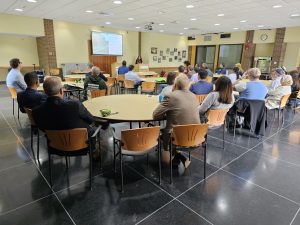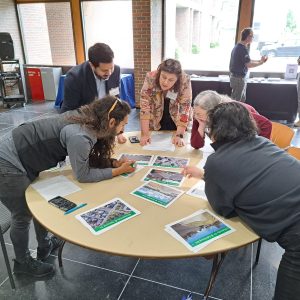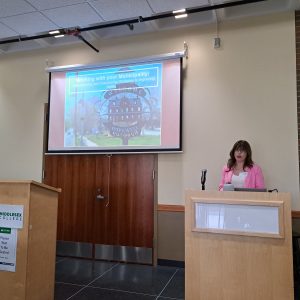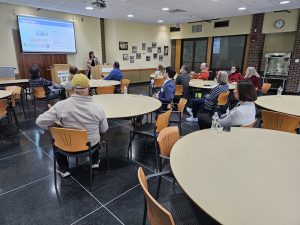 This past May, the New Jersey Department of Transportation’s (NJDOT) New Jersey Safe Routes Academy took place during the 2024 New Jersey Bike and Walk Summit at Middlesex College. Sessions were developed and organized in coordination with staff from the New Jersey Safe Routes Resource Center and New Jersey Bicycle and Pedestrian Resource Center, both funded and supported by NJDOT. The May Safe Routes Academy featured four sessions addressing topics such as designing for safety, working with local governments and transforming ideas into reality. The overall summit was hosted by the New Jersey Bike and Walk Coalition and featured keynote speakers including Transportation for America director Beth Osbourne and NJDEP Commissioner Shawn LaTourette.
This past May, the New Jersey Department of Transportation’s (NJDOT) New Jersey Safe Routes Academy took place during the 2024 New Jersey Bike and Walk Summit at Middlesex College. Sessions were developed and organized in coordination with staff from the New Jersey Safe Routes Resource Center and New Jersey Bicycle and Pedestrian Resource Center, both funded and supported by NJDOT. The May Safe Routes Academy featured four sessions addressing topics such as designing for safety, working with local governments and transforming ideas into reality. The overall summit was hosted by the New Jersey Bike and Walk Coalition and featured keynote speakers including Transportation for America director Beth Osbourne and NJDEP Commissioner Shawn LaTourette.
The first NJ Safe Routes Academy session was called “Where the Sidewalk Ends: Exploring Safe Street Design”. The presenters were NJDOT Principal Planner and State SRTS coordinator William Riviere, Bloustein School Postdoctoral Researcher Hannah Younes and Voorhees Transportation Center Senior Research Specialist James Sinclair. The session explored crash data and how to use it to increase safety. The presentation featured an interactive portion in which audience members were shown specific roads and asked for personal opinions on speed apportionment which established a healthy line of communication between the speakers and the audience. Presenters also discussed design methods that planners can use to decrease injuries. Learning about these design elements gave attendees an improved knowledge of safe street design and more planning ideas for their respective municipalities.
The next NJ Safe Routes Academy session, titled “Talk the Walk: Putting your Vision into a Plan,”  was concerned with helping attendees translate their visions for bicycle and pedestrian improvements into plans. Moderated by Bill Riviere, the session featured NJ Safe Routes Resource Center Research Project Manager Sean Meehan and Project Coordinator Jon Dugan presenting on how to develop and use school travel plans locally. They provided information and advice on how to get community members involved with a school travel plan, required plan elements, and completing walk to school assessments. During the session, attendees were able to participate in an interactive activity assisted by Resource Center staff and local SRTS Coordinators from New Jersey’s Transportation Management Associations. This activity featured maps and photo examples of intersections from real walk and bike assessments from throughout New Jersey. Participants were asked to note issues or concerns, discuss potential solutions improvements, and prioritize improvements. Both presenters also offered insight on finding essential resources such as local SRTS Coordinators, informative safety and design guides, and information on Complete and Green Streets policies.
was concerned with helping attendees translate their visions for bicycle and pedestrian improvements into plans. Moderated by Bill Riviere, the session featured NJ Safe Routes Resource Center Research Project Manager Sean Meehan and Project Coordinator Jon Dugan presenting on how to develop and use school travel plans locally. They provided information and advice on how to get community members involved with a school travel plan, required plan elements, and completing walk to school assessments. During the session, attendees were able to participate in an interactive activity assisted by Resource Center staff and local SRTS Coordinators from New Jersey’s Transportation Management Associations. This activity featured maps and photo examples of intersections from real walk and bike assessments from throughout New Jersey. Participants were asked to note issues or concerns, discuss potential solutions improvements, and prioritize improvements. Both presenters also offered insight on finding essential resources such as local SRTS Coordinators, informative safety and design guides, and information on Complete and Green Streets policies.
 Following this was “Build Better Streets: How to Work with your Municipality.” During this session, local advocates shared their personal experiences working within their own municipalities to improve the walking and bicycling environments. Speakers discussed their process of reaching out to other community members, partnering with regional stakeholders and advocates, and working with or within local government. Speaker Krista Weaver shared her story of becoming a Safe Streets advocate and being elected Council President of Hopewell. Eatontown Borough Council Member Candace Faust explained how she started slowly to make improvements throughout her town using visual examples and highlighting her grant application process. Lastly, Kathleen Ebert presented on how her desire for better sidewalks in her community of Point Pleasant led her to start a local Complete Streets campaign and how now she helps others through her work for the Greater Mercer TMA. The speakers delivered inspiring messages about starting small and having patience, with multiple real-life examples of how to effectively influence local changes that led to led to an engaging discussion.
Following this was “Build Better Streets: How to Work with your Municipality.” During this session, local advocates shared their personal experiences working within their own municipalities to improve the walking and bicycling environments. Speakers discussed their process of reaching out to other community members, partnering with regional stakeholders and advocates, and working with or within local government. Speaker Krista Weaver shared her story of becoming a Safe Streets advocate and being elected Council President of Hopewell. Eatontown Borough Council Member Candace Faust explained how she started slowly to make improvements throughout her town using visual examples and highlighting her grant application process. Lastly, Kathleen Ebert presented on how her desire for better sidewalks in her community of Point Pleasant led her to start a local Complete Streets campaign and how now she helps others through her work for the Greater Mercer TMA. The speakers delivered inspiring messages about starting small and having patience, with multiple real-life examples of how to effectively influence local changes that led to led to an engaging discussion.
The final session was led by Managing Director of the Alan M. Voorhees Transportation Center, Leigh Ann Von Hagen. It was called “Fund Your Project: Tips and Strategies for Successful Grant Applications” and it explored the financial side of safe streets planning. This session focused on insights into the various funding opportunities available to support bicycle and pedestrian improvements in New Jersey. It discussed state and federal grants, highlighting which types of projects are most appropriate for each funding source. The session also provided tips and strategies for crafting successful grant applications and for navigating the grant process. Resulting discussion with participants following the presentation highlighted resources needed to access funding, the level of effort required for different grant applications, and how best to match projects to appropriate grant sources.
 In addition to the NJ Safe Routes Academy sessions, Greg Woltman and Sam Rosenthal from the New Jersey Bicycle and Pedestrian Resource Center, hosted the session “Micromobility and Me: An Interactive Discussion on Low-Speed Electric Travel in NJ”. Their presentation provided an interactive environment to discuss low-speed electric mobility devices. The session began with questions about participants’ personal use of micromobility. The speakers then dove into how e-bikes and e-scooters are legislated in New Jersey and what laws impact micromobility users. Following the legal portion of the presentation was guidance on battery safety and taking devices on public transit. Towards the conclusion of the session, the presenters revealed how to access existing resources and announced that a micromobility guide is under development.
In addition to the NJ Safe Routes Academy sessions, Greg Woltman and Sam Rosenthal from the New Jersey Bicycle and Pedestrian Resource Center, hosted the session “Micromobility and Me: An Interactive Discussion on Low-Speed Electric Travel in NJ”. Their presentation provided an interactive environment to discuss low-speed electric mobility devices. The session began with questions about participants’ personal use of micromobility. The speakers then dove into how e-bikes and e-scooters are legislated in New Jersey and what laws impact micromobility users. Following the legal portion of the presentation was guidance on battery safety and taking devices on public transit. Towards the conclusion of the session, the presenters revealed how to access existing resources and announced that a micromobility guide is under development.
The 2024 NJ Safe Routes Academy was a definite success! The real-life examples presented by speakers fostered productive dialogue and encouraged the free exchange of ideas between presenters and audience members. A special thank you to all session speakers for sharing their expertise and experiences.
